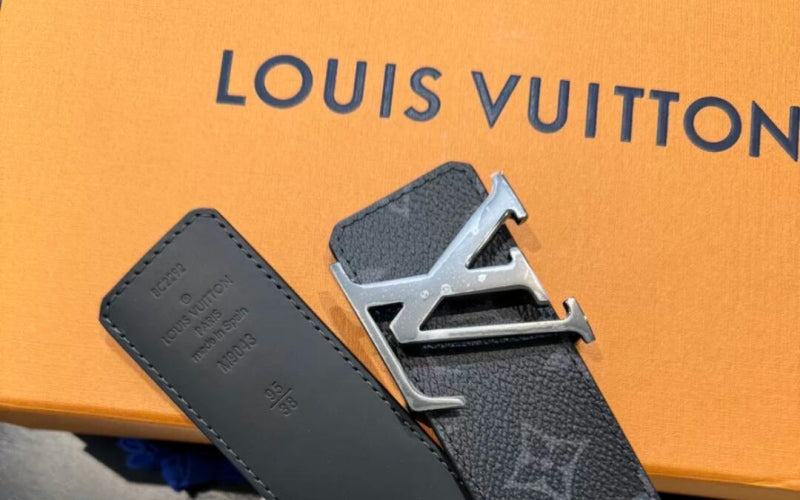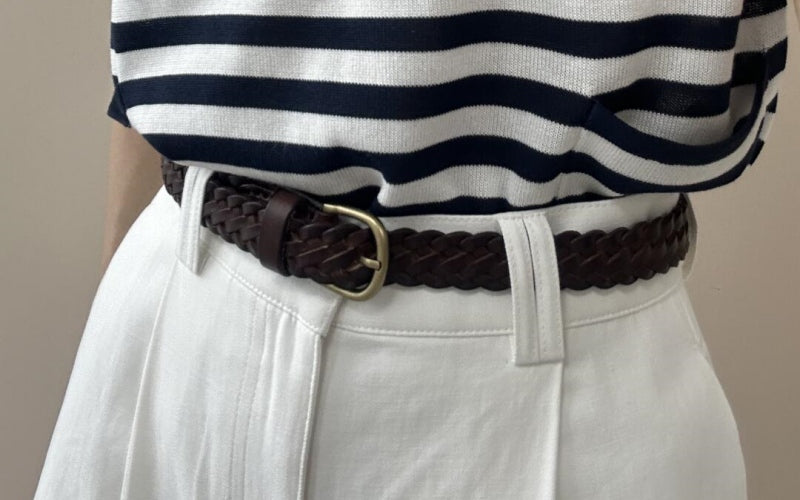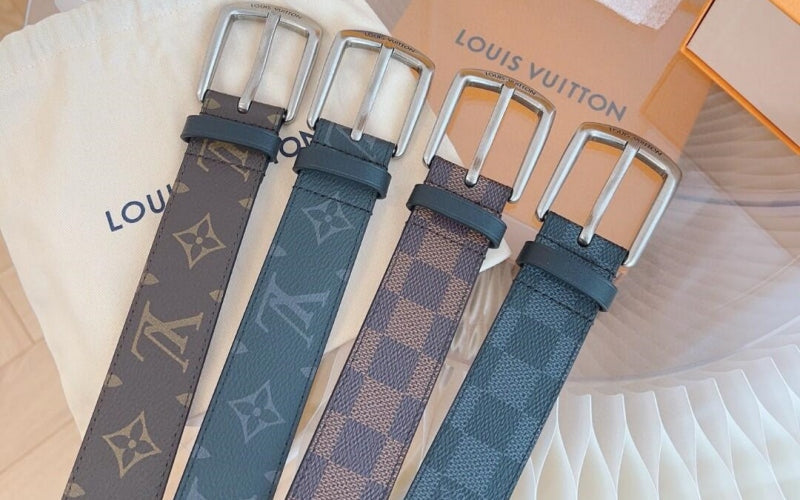
Why Are Designer Belts So Expensive? (12 Reasons EXPLAINED)
A few summers ago, I met a client who’d spent $600 on a designer belt. “I could’ve bought a plane ticket to Miami for this!” he laughed. Two years later, he sent me a photo of that same belt—now sun-bleached and scarred from hikes, beach days, and a kayaking mishap—with the caption: “Still my daily driver. Worth every penny.”
Designer belts often come with jaw-dropping price tags. But here’s the secret: they’re not just belts—they’re wearable art, status symbols, and lifelong investments rolled into one.
Let’s break down 12 reasons behind the cost and how to style these pieces to make them worth the splurge.
 This belt caught your eye? See our full collection — click the pic above.
This belt caught your eye? See our full collection — click the pic above.
1. Premium Leather: Not All Hides Are Created Equal
Designer belts start with leather that’s closer to fine wine than fast fashion. Brands like Beltley use full-grain leather, the top 10% of the hide, which retains natural imperfections like scars and insect bites. These aren’t flaws—they’re proof of authenticity.
Cheap alternatives? They’re often made from “genuine leather,” a sneaky term for split leather (the fibrous leftovers). These belts crack faster than a cellphone screen.
Beltley Example: Their Royal Oak Collection uses full-grain leather from free-range Italian cattle. The hides are hand-inspected for softness and uniformity.
Styling Tip: Pair a cognac-colored belt with navy suits—it adds warmth without looking like you tried too hard.
 This belt caught your eye? See our full collection — click the pic above.
This belt caught your eye? See our full collection — click the pic above.
2. The Tanning Process: Where Time = Money
Turning raw hides into butter-soft leather takes patience. Luxury brands like Beltley use vegetable tanning, a 60-day process using tree bark tannins. The result? Leather that ages into a rich patina.
Fast fashion uses chrome tanning, a chemical-heavy method done in 48 hours. It’s cheaper but leaves leather stiff and prone to discoloration.
Pro Hack: Rub a drop of water on the belt. Vegetable-tanned leather darkens slightly (like a memory); chrome-tanned leather repels it.
 This belt caught your eye? See our full collection — click the pic above.
This belt caught your eye? See our full collection — click the pic above.
3. Handcrafted Construction: No Machines, No Compromises
I once toured a Milan workshop where artisans spent 8 hours on a single belt—hand-cutting, hand-stitching, and burnishing edges with beeswax. Designer belts are built like tanks:
-
Double saddle stitching: Each stitch is a knot. If one breaks, the rest hold firm.
-
Burnished edges: Rubbed 50+ times for a mirror-like finish.
-
Reinforced holes: Brass eyelets prevent stretching.
Budget belts? Glued seams and flimsy stitching. I’ve seen belts unravel during job interviews.
Beltley’s Edge: Their Artisan Series belts come with a certificate signed by the craftsman.
 This belt caught your eye? See our full collection — click the pic above.
This belt caught your eye? See our full collection — click the pic above.
4. Designer Hardware: Buckles That Double as Heirlooms
A designer buckle isn’t just functional—it’s jewelry. Beltley’s Signature Medusa Buckle (inspired by Versace) is cast in solid brass and plated with 18k gold. It takes 14 hours to polish.
Cheap belts use zinc alloy buckles that tarnish faster than a politician’s reputation.
Styling Move: Match your buckle to your watch. Silver for monochrome outfits, gold for earth tones.
 This belt caught your eye? See our full collection — click the pic above.
This belt caught your eye? See our full collection — click the pic above.
5. Ethical & Sustainable Practices
Luxury brands pay a premium for ethics. Beltley partners with Certified B Corp tanneries that:
-
Recycle 95% of water used.
-
Source hides from stress-free, pasture-raised cattle.
-
Use solar-powered workshops.
Fast Fashion Reality: Many $30 belts fund exploitative labor and environmental damage.
Did You Know? Stress hormones in cattle create tougher hides. Happy cows = softer leather.
 This belt caught your eye? See our full collection — click the pic above.
This belt caught your eye? See our full collection — click the pic above.
6. Design Innovation: Beyond the Basic Strap
Designer belts are runway-worthy. Beltley’s design team spends months:
-
Sketching avant-garde buckles (think: geometric shapes, enamel inlays).
-
Experimenting with textures like crocodile embossing or woven leather.
-
Testing prototypes for comfort (no one wants a buckle that jabs their hip).
Budget Brands: Copy last season’s trends. I’ve seen “designer dupes” with clasps that snap mid-stride.
 This belt caught your eye? See our full collection — click the pic above.
This belt caught your eye? See our full collection — click the pic above.
7. Exclusivity: Limited Editions & Custom Orders
Scarcity drives desire. Beltley’s Phoenix Collection—limited to 500 belts worldwide—features hand-painted edges and numbered plaques.
Custom Orders can include:
-
Monogrammed initials in 24k gold.
-
Bespoke lengths for non-standard waist sizes.
-
Exotic leathers like ethically sourced python.
Pro Tip: Custom belts make killer anniversary gifts. (Trust me, it’s cheaper than divorce.)
 This belt caught your eye? See our full collection — click the pic above.
This belt caught your eye? See our full collection — click the pic above.
8. Brand Heritage: Decades of Expertise
Luxury brands like Gucci or Beltley have generational knowledge. Beltley’s founder trained under a Florentine leathersmith whose family had been in the trade since the 1800s. This expertise ensures:
-
Perfect dye penetration (no fading).
-
Precision stitching (8 stitches per inch).
-
Buckles that won’t warp or rust.
New Brands often lack this institutional wisdom—you’re paying for their trial-and-error period.
 This belt caught your eye? See our full collection — click the pic above.
This belt caught your eye? See our full collection — click the pic above.
9. Marketing & Celebrity Endorsements
Ever noticed Rihanna rocking a diamond-encrusted belt? That visibility isn’t free. Designers invest heavily in:
-
Celebrity partnerships.
-
High-fashion photoshoots.
-
Front-row runway seats.
But Here’s the Twist: Beltley avoids celebrity markups by focusing on craftsmanship over hype.
10. Import Costs: The Hidden Markup
That Italian leather belt? It’s taxed at every border. Luxury brands absorb:
-
Tariffs on raw materials.
-
Shipping insurance for delicate goods.
-
Customs delays (one Beltley shipment got stuck for 3 weeks in a monsoon!).
Budget Workaround: Some brands use local materials but sacrifice quality.
 This belt caught your eye? See our full collection — click the pic above.
This belt caught your eye? See our full collection — click the pic above.
11. Retail Experience: Unboxing Luxury
Designer belts come with ceremonial unboxing:
-
Embroidered dust bags.
-
Handwritten notes.
-
Lifetime repair guarantees.
Beltley even includes a mini leather conditioner with every order.
Budget Unboxing: A plastic bag and a crumpled invoice.
12. Resale Value: Investment Pieces
A well-maintained designer belt can appreciate. Hermès belts often resell for 120% retail price. Beltley’s vintage collections fetch up to $800 on eBay.
Cheap Belts: Worthless after 6 months.
How to Style Designer Belts Without Looking Try-Hard
-
Office Ready: 1.25” black belt + Oxfords. Keep the buckle minimal.
-
Weekend Errands: 1.5” woven belt + white sneakers. Let the belt peek under an untucked shirt.
-
Date Night: Beltley’s Midnight Serpent (black croc-embossed) with a tailored blazer.
Celeb Hack: Timothée Chalamet layers skinny belts over oversized coats—quirky but cool.
FAQs: Your Burning Questions, Answered
-
“Can I wear a designer belt daily?”
Rotate between 2-3 to prevent wear. Condition monthly. -
“How do I fix a squeaky belt?”
Rub the inside with a dab of beeswax or lip balm. -
“Are designer belts vegan-friendly?”
Beltley offers a Eucalyptus Leather line—plant-based and biodegradable. -
“Do designer belts stretch?”
Quality belts mold to your shape but rebound. Cheap ones bag like old sweatpants. -
“What’s the ROI on a $500 belt?”
Cost per wear: If worn twice weekly for 10 years, it’s $0.48 per day vs. $0.80 for a $40 belt.
Final Word: Are Designer Belts Worth It?
A designer belt isn’t an accessory—it’s a legacy. It’s the confidence boost before a big pitch, the heirloom your grandkids will fight over, and a nod to craftsmanship in a disposable world. Brands like Beltley prove that true luxury isn’t about logos—it’s about enduring quality.
Ready to invest? Use code BELTLEY15 at Beltley.com for 15% off your first order. Because life’s too short for belts that sag, snap, or squeak.

